- Species of Interest
- Minke Whale
- Fin Whale
- Long-finned Pilot Whale
- Bryde's Whale
- Sei Whale
- Blue Whale
Species of Interest
The North Atlantic and the North Pacific abounds in whales, but for most of them, we know very little about their migration patterns and wintering grounds. The fast-moving rorquals (the fin, sei, Bryde’s, blue and minke whales) and large dolphin species such as pilot whales, are among those with mysterious migratory patterns. These species are abundant and of great importance to both ecosystems and coastal communities. However, scientists still do not know exactly where they migrate in winter, nor whether there are separate stocks with separate migrations, although several plausible stock structure hypotheses have been developed.
Until now it has not been possible to develop long-lasting satellite tags for these species. The MINTAG is supposed to adress the problem previously encountered with the tagging of these species.
However, for the development of the MINTAG, the project will concentrate on 3 species: fin, minke and long-finned pilot whale. When the MINTAG is successfully developed, it will then also be used on species like bryde’s, sei and blue whale.
Minke Whale (Balaenoptera acutorostrata)
The common minke whale is the smallest of the rorquals. It typically obtains a length of 8-9 m and a weight of about 8 tonnes in the North Atlantic. Females are somewhat larger than males. Common minke whales are black or dark grey dorsally and white on the ventral side. A transverse white band across the flippers is characteristic for the species in the Northern Hemisphere. With a worldwide distribution, it is the most common of the rorquals. The common minke whale feeds on a wide variety of fish and invertebrates and is considered an important predator in the marine ecosystem.
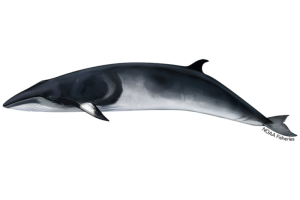
Distribution
Common minke whales have extensive seasonal migrations, moving from wintering areas in the tropics or sub-tropics to higher latitude feeding areas in the summer.
North Atlantic
Major summering areas include the North Sea, the Norwegian Sea, the Barents Sea, the coastal waters of Iceland, east and West Greenland, Newfoundland and Labrador, and the northeastern coast of the USA.
North Pacific
In summer they are widely distributed from the southern Chukchi Sea south to the east China Sea, 30°N in the central Pacific, and the coast of central Baja California. In the western North Pacific, they distribute widely from coastal to pelagic areas, including in the neighboring Sea of Okhotsk, Sea of Japan, Yellow Sea and East China Sea. At least two stocks have been recognized for the western North Pacific.
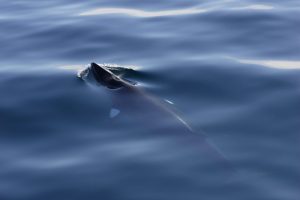
Conservation and Management
The common minke whale is listed as being of ‘Least Concern’ on both the European regional and global IUCN Red List (2008 and 2018, respectively). It is not red-listed in any of the NAMMCO members countries or Japan.
In the North Atlantic and North Pacific, the minke whale is hunted off Greenland, Norway, Iceland and Japan; it also subjected to some by-catch and entanglement. The conservation and use of minke whales are managed by the International Whaling Commission (Greenland), NAMMCO (Iceland), Norway and Japan. All stocks are currently considered to be in a healthy state and not threatened by present levels of use for human purposes.
Fin Whale (Balaenoptera physalus)
The fin whale is the second-largest living animal, second in size only to the blue whale. Fin whales are the most streamlined in appearance of all the rorquals and have been nicknamed “razorback”. They are dark grey to brownish black in colour along the top of the body, with an asymmetrically pigmented head. Females are slightly longer than males. Adult males average 19 m and adult females 20.5 m in the Northern Hemisphere. They weigh between 45 and 75 tonnes. Fin whale blows are tall and impressive and can often be seen at a great distance. Fin whales are sleek, fast swimmers.
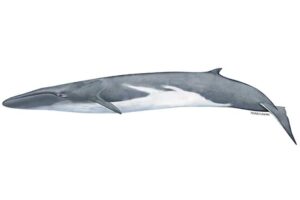
Distribution
The fin whale has a worldwide distribution. It occurs in the Atlantic, Pacific, Indian and Arctic Oceans. In all oceans, it ranges from tropical to polar regions, primarily in temperate to polar latitudes. It is rarely found in tropical or ice-covered polar seas. Fin whales are largely pelagic (open-ocean dwellers), but may be seen in coastal waters in some areas, sometimes occurring in waters as shallow as 30 m.
North Atlantic
The species is present in summer over the entire Eastern North Atlantic, ranging from temperate to polar waters. At this time of year, it is most common off Nova Scotia and Newfoundland, in the Davis Strait off Western Greenland, in the East Greenland – Iceland – Jan Mayen area and west of the Iberian Peninsula.
North Pacific
In summer they distribute in the Chukchi Sea, around the Aleutian Islands, in the Gulf of Alaska and down to California in the east. They distribute from the Sea of Okhotsk down to the Sea of Japan and the coast of Japan in the west.
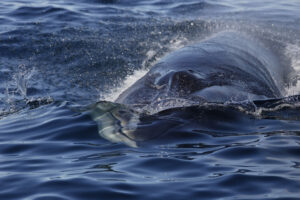
Conservation and Management
In the most recent assessment (2018), the species is listed as ‘Vulnerable and increasing’ on the global IUCN Red List. For the European population, the listing is ‘Near Threatened’ (IUCN Red List 2007).
In the North Atlantic and North Pacific, the fin whale is hunted off Greenland and Iceland. Fin whales have been reported entangled, but rarely, off Greenland and Japan (2 and 14 in the last twenty years respectively).
The conservation and use of fin whales are managed by the International Whaling Commission (Greenland) and NAMMCO (Iceland).
There is clear evidence of their recovery in the North Atlantic. The population is now likely close to or larger than before the onset of modern whaling in the 1880s.
The populations of the Central stock (EG+WI+[EI+F]) and the West Greenland area (WG), the two areas from which catches are taken, are considered in a healthy state and able to sustain a managed harvest (see assessments: IWC 2016, NAMMCO 2017).
Long-finned pilot whale (Globicephala melas)
The long-finned pilot whale is a medium-sized toothed whale that is found in temperate and sub polar areas of the North Atlantic and in mid-latitudes throughout the Southern Hemispheres. It is primarily an oceanic, squid-eating species. Males are larger than females, reaching a length of 6.3 m and a weight of 2.5 tonnes. They are dark brown to black in colour, with a light anchor-shaped pattern on the belly. The pilot whale is a social species, found in groups of tens to hundreds of animals.
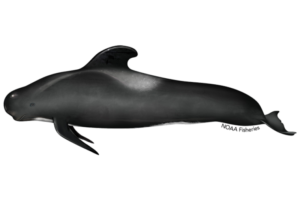
Distribution
Long-finned pilot whales have an anti-tropical distribution in temperate and subpolar zones of the Northern and Southern Hemispheres. In the Northern Hemisphere, this species is found only in the North Atlantic Ocean, including the North Sea, Mediterranean Sea, and the Gulf of St. Lawrence. It has a typical temperature range of 0–25° C.
North Atlantic
In the summer months, their range stretches in from Disco Bay in western Greenland, to Iceland and up to the southern portion of Svalbard waters and down to northwest Africa. Most common in the Irminger Sea and in the area between Iceland and Scotland.
North Pacific
The long-finned pilot whale is not present in the North Pacific, only the short-finned pilot whale.
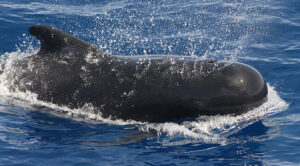
Conservation and Management
The species is listed as ‘Least Concern’ on the global IUCN Red List (2018) and on the Greenlandic and Icelandic Red Lists. It is protected in Norway and Iceland.
In the North Atlantic, the long-finned pilot whale is hunted off Greenland and the Faroe Islands; it also subjected to some by-catch in all countries. The conservation and use of pilot whales are managed by NAMMCO (Faroe Islands and Greenland).
The Faroese pilot whale hunt is regulated by legislation that deals with all aspects of the hunt in detail, including driving procedures, beaching, killing methods, obligatory training of hunters, approved equipment, valuation, distribution and beach clean-up. These regulations are subject to regular review and have been updated and revised several times in recent years, both to keep them consistent with technological developments and to refine some of the organisational aspects of the drive and the distribution
Bryde’s Whale (Balaenoptera edeni)
Bryde’s whales live in all oceans between 40° south to 40° north and are also known as “tropical whales” due to their preference for waters of 16°C or higher. They can be between 12-17 m long and weigh up to 40 t. They have a close resemblance to sei whales, however, are smaller and have three ridges in front of the blowhole, while the sei whale as one. Their bodies are sleek with slender flippers. Some populations of Bryde’s whales do not migrate while others do, which is a unique feature among migrating baleen whales. Usually, Bryde’s whales are seen alone or in pairs. They feed on a variety of prey including krill but also fish.

Distribution
North Atlantic
With their distribution south of 40° north, the Bryde’s whale does not appear in the waters of NAMMCO member countries.
North Pacific
In summer they distribute widely in coastal and pelagic areas of the North Pacific, ranging north to the East China Sea, Honshu (mainland of Japan), around 45°N in the central North Pacific, and southern California. Two sub-species exist in the North Pacific, one with coastal habit and the other pelagic.
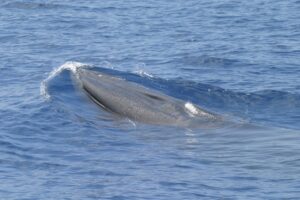
Conservation and Management
The bryde’s whale is listed as “Least Concern” on the global IUCN Red List (last assessed 2017) and not red-listed in Japan (Red List Japan, 2020).
In the North Atlantic and North Pacific, the Bryde’s whale is only hunted off Japan; by-catch and entanglement in Japanese waters are very seldomly reported.
The conservation and use of Bryde’s whales in Japanese waters is managed by Japan.
Sei Whale (Balaenoptera borealis)
The sei whale is the third largest of the rorquals and closely resembles both the Bryde’s and fin whale. The species has a dark grey colouration dorsally and lighter markings on its underside. It has a more southerly distribution than other large whales found in the North Atlantic and differs from other baleen whales in its ability to utilise different feeding techniques. These different techniques make it much more capable of switching between prey taxa. The sei whale is predominately found offshore, alone or in small groups. Knowledge about this whale is limited, as its range and distribution do not coincide with most other whales and can fluctuate from year to year.

Distribution
Sei whales are found throughout the world’s oceans and are present in the North Atlantic, Pacific and Southern Oceans in subtropical, temperate, and subpolar waters. They prefer deep water offshore throughout their range. It is currently unknown where sei whales breed.
North Atlantic
Three stocks are currently recognised by the IWC:
Nova Scotia (including the waters off the east coast of the U.S.A.)
Iceland-Denmark Strait
Eastern (including the waters of Spain, Portugal, British Isles, Faroe Islands, and Norway)
In the North Atlantic, the sei whale is most abundant between West Iceland and Southeast Greenland. It is rare along the Norwegian coast and in British waters.
North Pacific
In summer they distribute from California to the Gulf of Alaska in the east, across the Bering Sea and down to the coast of Japan and the Korean Peninsula in the west.
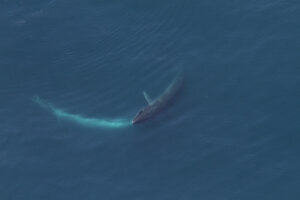
Conservation and Management
In the most recent assessment (2018) the species is listed as ‘Endangered but increasing’, bordering on ‘Vulnerable’ in the global IUCN Red List.
In the North Atlantic and North Pacific, the sei whale is only hunted off Japan. No by-catch or entanglement have been reported by NAMMCO countries and very rarely in Japanese waters.
The conservation and use of sei whales in Japanese waters is managed by Japan.
Blue Whale (Balaenoptera musculus)
The blue whale is a cosmopolitan species, found in all the major oceans of the world. It is the largest of the baleen whales and the largest animal to have ever lived. It appears lighter in colour than most other large whales and has a bluish grey mottled pigmentation with light and dark patches.
The average size of blue whales in the Northern Hemisphere is 24-28 m, with an average weight between 50 and 150 tonnes. Females are slightly larger than males. Their spout can reach up to 12 m and their vocalizations can be heard for hundreds of kilometres. Despite their large size, blue whales feed almost exclusively on tiny kril
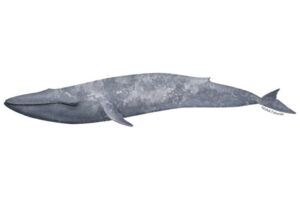
Distribution
The blue whale is a cosmopolitan species found in all the major oceans of the world, with a tendency to remain in deep waters. The population structure is not clear, and both three and four large geographic regions have been suggested. The three regions currently accepted are the North Atlantic, North Pacific and Southern Ocean.
North Atlantic
The available sightings and acoustic data show a wide-ranging use of the North Atlantic, with blue whales moving over great distances and being observed from north of Disko Bay and off Svalbard in the north, to south of Bermuda and off the Cape Verde Islands. The largest aggregation in the North Atlantic is found around Iceland.
North Pacific
In summer they range in the immediate offshore waters from the Sanriku (Pacific coast of northern Honshu), northward and eastward along the Kuril Islands and the southern side of the Aleutian Islands, around the Gulf of Alaska, and southeastward as far as central Baja California.
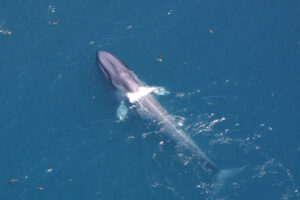
Conservation and Management
In the most recent assessment (2018) the species is listed as ‘Endangered but increasing’ in the global IUCN Red List. There are clear indications of an increase in the Central North Atlantic. It is listed as ‘Vulnerable’ on both the Norwegian and Icelandic national red lists.
Blue whales are protected by all NAMMCO member countries and Japan.
